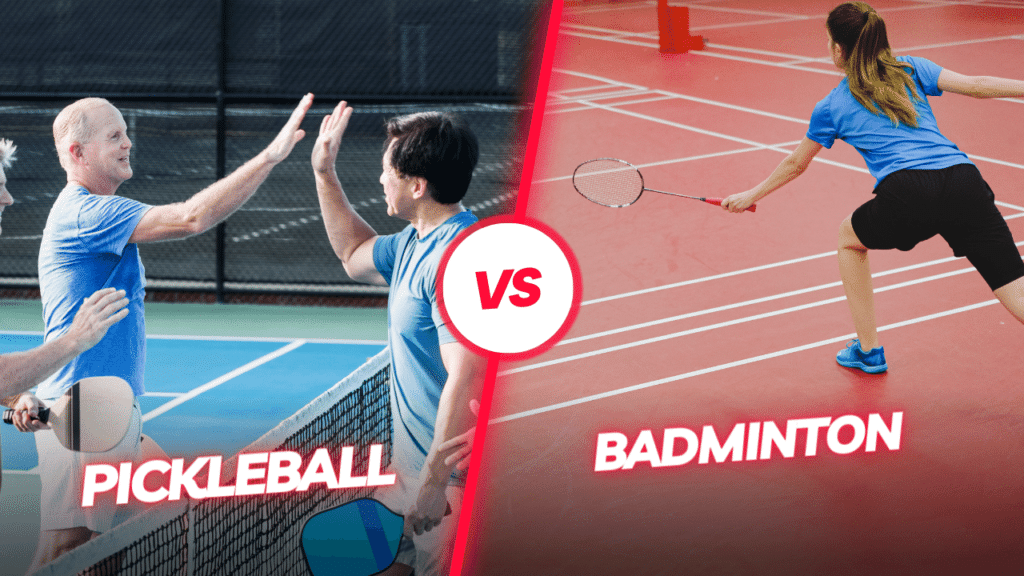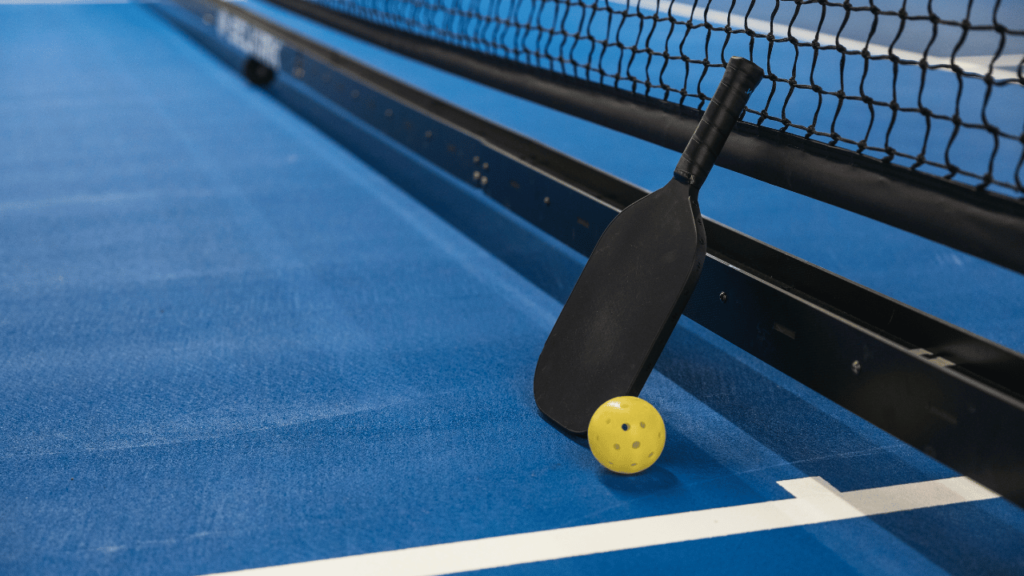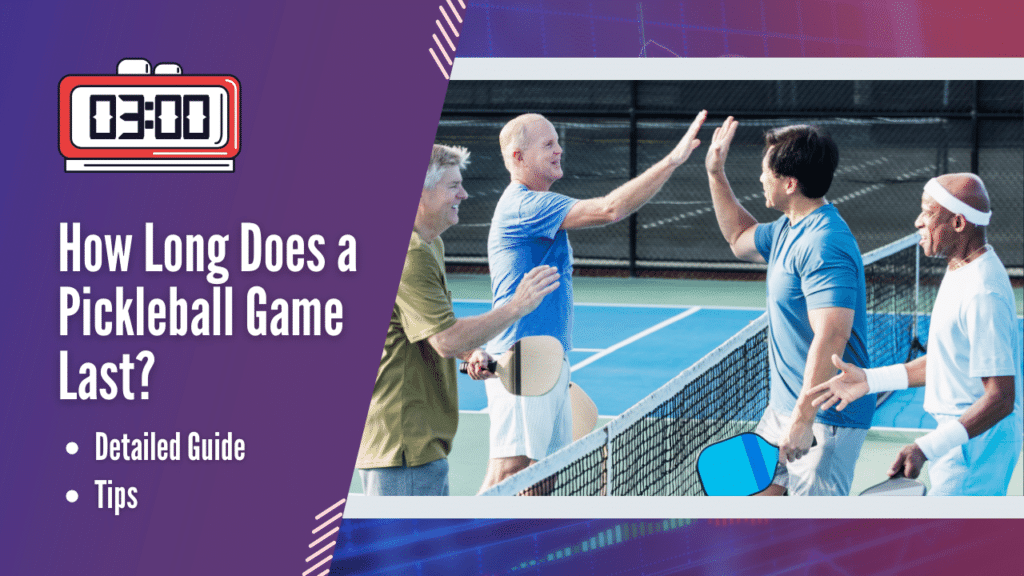Pickleball and badminton are two popular racket sports that have been gaining immense popularity in recent years. With an increasing number of people seeking active and engaging recreational activities, both sports offer fun and excitement for players of all ages and skill levels.
In this article, we will delve into the world of pickleball and badminton courts, exploring their key differences and highlighting the unique aspects that make each sport special.
Whether you’re a seasoned player looking to understand the distinctions or a beginner trying to choose between the two, this comprehensive comparison will provide you with valuable insights about how does a pickleball court differ from a badminton court.
Understanding the Basics

- Pickleball Court: Pickleball is often played on a court with the dimensions of 20 feet wide and 44 feet long for both singles and doubles play. It resembles a miniature tennis court, with a non-volley zone, commonly known as the “kitchen,” situated on each side of the net. The kitchen extends 7 feet from the net and prohibits players from volleying while standing within it.
- Badminton Court: Badminton courts are slightly different, as they have distinct dimensions for singles and doubles play. For singles, the court is 17 feet wide and 44 feet long, while for doubles, it expands to 20 feet wide. The net is higher in badminton compared to pickleball, standing at 5 feet in singles and 5 feet 1 inch in doubles play.
Table 1: Court Dimensions
| Sport | Court Width (feet) | Court Length (feet) | Non-Volley Zone (“Kitchen”) Width (feet) |
| Pickleball | 20 | 44 | 7 |
| Badminton | 17 (Singles) | 44 | N/A (no specific kitchen zone) |
Court Surface and Material
- Pickleball Court: Pickleball courts are typically made of a hard surface, such as concrete or asphalt, which offers players a consistent and predictable bounce. Some venues may use cushioned surfaces to reduce the impact on players’ joints and improve overall comfort during prolonged play.
- Badminton Court: In contrast, badminton courts have a wooden surface that provides a slightly softer feel underfoot. This choice of material caters to the sport’s fast-paced nature, allowing players to move swiftly and change direction effortlessly.
Net Specifications
- Pickleball Court: The net in pickleball is set at a height of 36 inches at the sidelines and 34 inches at the center. This lower net height encourages aggressive gameplay, with players often engaging in dynamic rallies and strategic volleys.
- Badminton Court: Badminton nets, on the other hand, are set higher to accommodate the sport’s characteristic high-flying shuttlecock. The net stands at 5 feet in the center and tapers down to 5 feet 1 inch at the posts.
Table 2: Net Specifications
| Sport | Net Height at Posts (feet) | Net Height at Center (feet) |
| Pickleball | 3’0″ | 2’10” |
| Badminton | 5’1″ | 5’0″ |
Equipment Differences

- Pickleball Paddle: Pickleball paddles are typically made of lightweight materials such as graphite, composite, or wood. The paddles have a solid surface with no strings, allowing players to direct the ball’s trajectory with greater precision and control.
- Badminton Racket: Badminton rackets are designed with a lighter frame and strung with thin, high-tension strings. This construction enables players to generate tremendous racket head speed and execute lightning-fast shots, contributing to the sport’s thrilling rallies.
Table 3: Equipment Comparison
| Aspect | Pickleball Paddle | Badminton Racket |
| Materials | Graphite, Composite, Wood | Lightweight frame with high-tension strings |
| Design | Solid surface without strings | Strung with thin, high-tension strings |
| Purpose | Offers precision and control for shot placement | Enables fast swings and quick, powerful shots |
Scoring Systems
- Pickleball Scoring: Pickleball follows a straightforward scoring system, with points being awarded only to the serving team. Games are typically played to 11 points, and a two-point margin is required to win. Each server gets only one attempt, making it crucial to capitalize on the opportunity.
- Badminton Scoring: In badminton, players can score points whether serving or receiving. Traditional games are played to 21 points, and a two-point advantage is also necessary to secure victory. Badminton’s scoring system allows for comebacks and extended play, making it more unpredictable at times.
Table 4: Scoring Systems
| Sport | Points Awarded per Serve | Games Played To | Winning Margin |
| Pickleball | 1 (only serving team) | 11 | 2 points |
| Badminton | 1 (both teams can score) | 21 | 2 points |
Game Dynamics and Gameplay
- Pickleball Gameplay: Pickleball combines elements from various sports like tennis, badminton, and table tennis. The game’s slower pace and emphasis on shot placement require players to strategize and outmaneuver their opponents rather than relying solely on power.
- Badminton Gameplay: Badminton, on the other hand, is known for its fast-paced, explosive rallies. Players need to exhibit agility, reflexes, and quick decision-making skills to thrive in the fast-paced environment of the court.
Table 5: Game Dynamics and Gameplay
| Aspect | Pickleball | Badminton |
| Gameplay Style | Strategic and precise shots | Fast-paced and explosive rallies |
| Court Coverage | Players stay closer to the net and kitchen area | Players move rapidly around the entire court |
| Volleying | Frequent volleying at the net | Limited volleying due to higher net height |
| Shot Variety | Dinks, lobs, and drop shots are common | Smashes, clears, and drops are commonly used |
Serving Techniques
- Pickleball Serving: In pickleball, players use an underhand serve, known as the “dink” or “drop shot,” to initiate the point. The objective is to softly land the ball in the non-volley zone, making it challenging for the opponent to return.
- Badminton Serving: Badminton serves often involve overhead shots, such as the “high serve” and the “flick serve,” which aim to put pressure on the receiver and set up an advantageous position for the serving side.
Table 6: Serving Techniques
| Aspect | Pickleball | Badminton |
| Serving Types | Underhand serves (dinks or drop shots) | Overhead serves (high serve or flick serve) |
| Importance of Serve | Crucial to set up the point and control | Puts pressure on the receiver and initiates play |
Pickleball vs. Badminton: Physical Demands

Pickleball and badminton place distinct physical demands on players:
- Pickleball: Pickleball is renowned for being a sport suitable for players of all ages and fitness levels. It provides a great cardiovascular workout, requires less lateral movement, and is gentle on the joints.
- Badminton: Badminton’s high-intensity rallies demand explosive movements and exceptional hand-eye coordination. Players must possess strong stamina and quick reflexes to keep up with the pace of the game.
Table 7: Physical Demands
| Aspect | Pickleball | Badminton |
| Intensity | Lower intensity, gentler movements | High-intensity, explosive rallies |
| Fitness | Suitable for all ages and levels | Requires strong stamina |
| Joints Impact | Gentle on joints | Demands quick movements |
Accessibility and Popularity
Pickleball and badminton have seen remarkable growth in popularity worldwide:
- Pickleball: Pickleball is gaining traction as one of the fastest-growing sports globally, with a surge in recreational facilities and clubs offering ample opportunities for players to join the community.
- Badminton: Badminton, having a rich history and strong cultural presence in various countries, continues to attract enthusiasts from diverse backgrounds, solidifying its status as one of the most widely played racket sports worldwide.
Table 8: Accessibility and Popularity
| Aspect | Pickleball | Badminton |
| Global Popularity | Rapidly growing worldwide | Popular in various countries and regions |
| Availability of Facilities | Increasing number of courts and clubs | Wide availability of badminton facilities |
Pickleball and Badminton Community
Both sports foster a sense of community and inclusivity:
- Pickleball: The friendly and welcoming atmosphere of pickleball courts often encourages beginners to join in and learn from more experienced players, creating a tight-knit community.
- Badminton: Badminton enthusiasts often find themselves forming close connections with fellow players, participating in local clubs, and engaging in social events centered around the sport.
Table 9: Community and Inclusivity
| Aspect | Pickleball | Badminton |
| Social Aspect | Friendly and welcoming atmosphere | Strong community bonding among players |
| Inclusivity | Encourages beginners to join and learn | Embraces players of diverse backgrounds |
How to Choose Between the Two
When deciding between pickleball and badminton, consider the following factors:
- Playing Style: If you enjoy strategic gameplay and gentler movements, pickleball might be your ideal choice. On the other hand, if you crave fast-paced action and exhilarating rallies, badminton could be your game.
- Physical Demands: Assess your fitness level and any physical limitations to determine which sport aligns better with your capabilities.
- Community and Accessibility: Check the availability of facilities and clubs in your area to ensure you can easily participate in your preferred sport.
Conclusion
In conclusion, pickleball and badminton courts offer distinct experiences and challenges for players. While pickleball emphasizes precision and strategy, badminton focuses on speed and agility. Both sports have thriving communities and offer unique health and social benefits. Whether you choose to pick up a pickleball paddle or a badminton racket, both games promise endless fun and the opportunity to build lasting memories on the court.
FAQs:
What is the primary difference between pickleball and badminton courts?
The primary difference lies in the court dimensions, net height, and surface materials, which impact gameplay dynamics and style.
Can you play pickleball on a badminton court?
Yes, you can play pickleball on a badminton court. In fact, many recreational facilities and community centers use existing badminton courts to host pickleball matches. Since the court dimensions of both sports are similar in width, players can set up pickleball nets on a badminton court to enjoy the game. However, it’s important to note that badminton courts have a higher net than pickleball courts, which may slightly impact gameplay dynamics.
What is pickleball and badminton?
Pickleball: Pickleball is a paddle sport that combines elements from tennis, badminton, and table tennis. It is played on a court with the dimensions of 20 feet wide and 44 feet long for both singles and doubles play. The game involves hitting a perforated plastic ball over the net using a paddle, with the objective of outmaneuvering opponents and scoring points.
Badminton: Badminton is a popular racket sport played on a court with varying dimensions for singles and doubles play. The sport involves hitting a shuttlecock (birdie) over the net with a lightweight racket, aiming to score points by landing the shuttlecock in the opponent’s court.
What makes pickleball different from other racket sports?
Pickleball stands out from other racket sports due to its unique blend of features:
a) Court Size: Pickleball courts are smaller than tennis courts and often require less lateral movement, making it suitable for players of all ages and fitness levels.
b) Paddle Design: Unlike tennis or badminton rackets, pickleball paddles have a solid surface with no strings, allowing players to have greater control over shots.
c) Serving Style: Pickleball uses an underhand serve, which differs from the overhead serves commonly seen in tennis and badminton.
d) Non-Volley Zone: Pickleball courts have a designated non-volley zone near the net, often referred to as the “kitchen,” where players cannot volley the ball.
Which sport is most similar to pickleball?
Pickleball shares similarities with both tennis and badminton, but it is most similar to badminton. Both pickleball and badminton are played on smaller courts compared to tennis, and players use lightweight rackets to hit a ball or shuttlecock over the net. However, pickleball’s unique characteristics, such as the non-volley zone and the use of paddles, set it apart from badminton and make it a distinct sport in its own right.
Why do they call the game pickleball?
The name “pickleball” has an interesting origin. The game was invented in 1965 by Joel Pritchard, William Bell, and Barney McCallum in the United States. The story goes that the name “pickleball” was inspired by the Pritchard family’s dog, Pickles. According to the family, the dog had a habit of running off with the ball during the early days of the game, prompting them to playfully refer to it as “Pickle’s ball.” Over time, the name stuck and eventually became “pickleball,” the name we know today for this popular and enjoyable sport.



